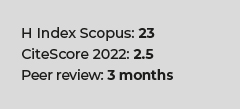Nutritional status associated with demographic characteristics in older peruvian adults
DOI:
https://doi.org/10.17843/rpmesp.2014.313.82Keywords:
Aged, Thinness, Overweight, Obesity, EpidemiologyAbstract
Objectives. To describe the nutritional status in older adults and its association with sociodemographic characteristics. Materials and methods. A cross-sectional study was conducted. Sampling was probabilistic, stratified and multistage. Nutritional status was assessed by body mass index (BMI) according to the classification of nutritional status for the elderly from the Ministry of Health of Peru. The statistical analysis considered the necessary weight for complex samples. Results. The study included 7,267 older adults. 26.8% of participants were underweight, 21.7% overweight, 10.6% obese and 40.8% normal. The average age in the sample was 70.1 ± 8.3 years. Illiteracy (OR 1.9; 95% CI 1.2-3.0), primary education (OR 1.9; 95% CI 1.3-2.9), extreme poverty (OR 2.0; 95% CI 1.6-2.5), living in rural areas (OR 1.8; 95% CI 1.5-2.1), living in the mountains (OR 1.6; 95% CI 1.2-2.2) or jungle (OR 1.6; 95% CI 1.1-2.2) were found associated with underweight. Females (OR 1.8; 95% CI 1.4-2.1), living in urban areas (OR 2.0; 95% CI 1.6-2.5), living in the coastal region (OR 1.5; 95% CI 1.2- 1.8); and not classified as poor (OR 1.9; 95% CI 1.3-2.9) were associated with overweight. Female sex (OR 3.1; 95% CI 2.3-4.1), primary education (OR 2.4; 95% CI 1.5-4.0) and secondary (OR 2.0; 95% CI 1.2-3.4); live in urban areas (OR 2.2; 95% CI 1.6-2.9), inhabiting the coast (OR 1.8; 95% CI 1.3-2.4), Metro (OR 1.6, 95% CI 1.1-2.2) and jungle (OR 1.6; 95% CI 1.1-2.2), and not classified as poor (OR 3.5; 95% CI 1.8-7.0) were associated with obesity. Conclusions. The data suggest that both underweight and overweight are common in the elderly population studied.Downloads
Download data is not yet available.
Downloads
Published
2014-09-25
Issue
Section
Research Articles
How to Cite
1.
Tarqui-Mamani C, Alvarez-Dongo D, Espinoza-Oriundo P, Gomez-Guizado G. Nutritional status associated with demographic characteristics in older peruvian adults. Rev Peru Med Exp Salud Publica [Internet]. 2014 Sep. 25 [cited 2024 Apr. 18];31(3). Available from: https://rpmesp.ins.gob.pe/index.php/rpmesp/article/view/82



























